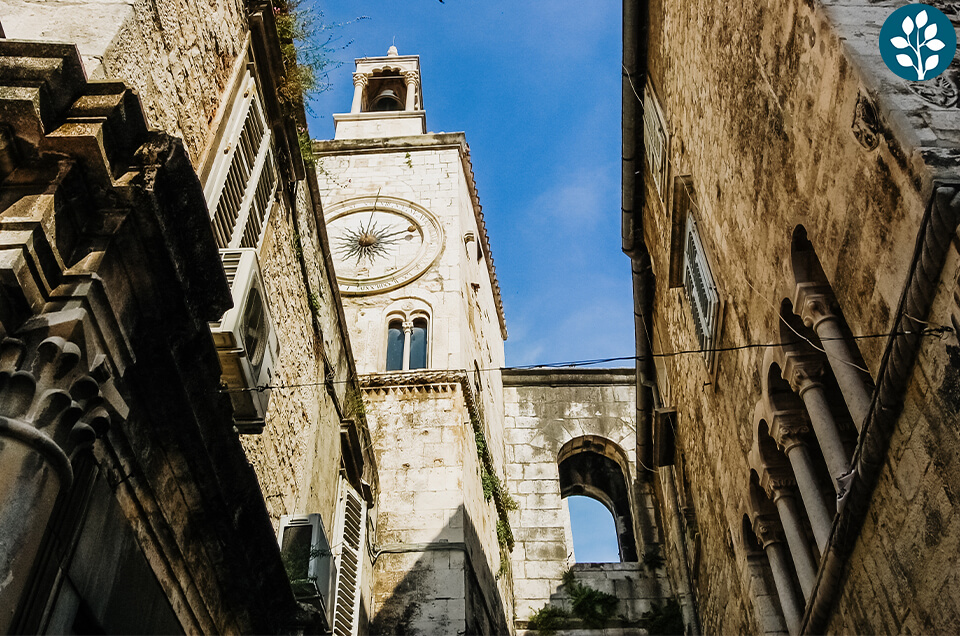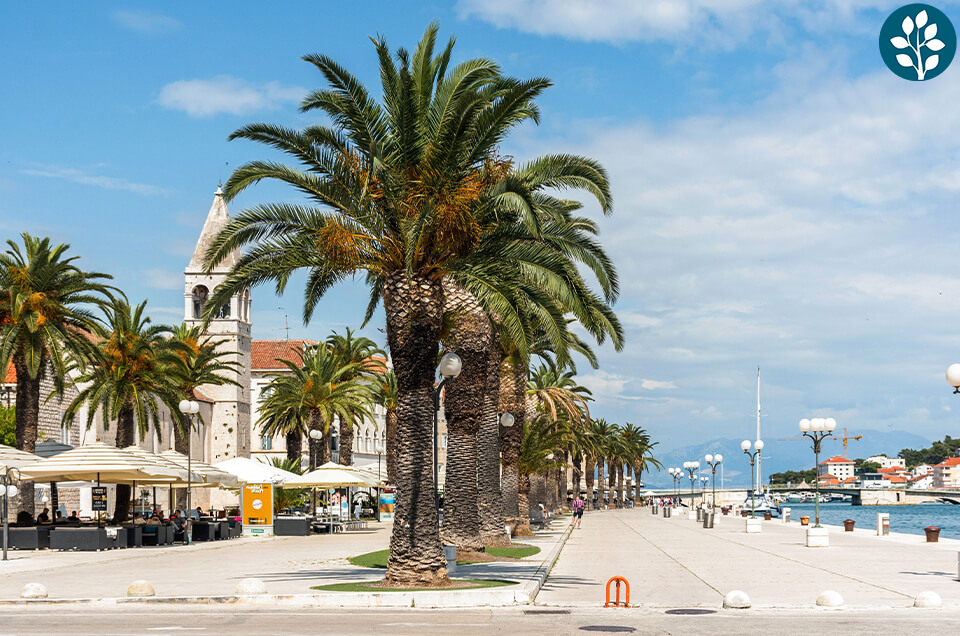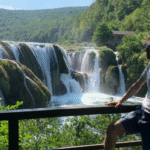Table of content:
- Introduction
- Where is Split Croatia?
- List What to Do in Split Croatia
- Grab the Thumb And Make a Wish
- Conclusion
Introduction
As the largest city in Croatia, Split captivates every new tourist with its beauty and historical background. This city is nearly 2000 years old and carries with it many historical stories that have followed it throughout the years.
In Split, you’ll find endless entertainment. When you find yourself in Split Croatia, make sure to make the most of every minute of your stay there, to be able to visit and see everything that this significant Croatian city offers you.
There are many reasons why Balkland chose Split as one of the destinations for this Balkan trip. The main reason is that you will get to know the interesting history and beauties of this ancient city. Below, you will find a list of What to do in Split Croatia, which will help you make the most of your time spent in this city.
Where is Split Croatia?
Located in Croatia, in the Dalmatian region, Split is one of the largest and most beautiful coastal cities in the country. According to the latest census, just over 160,000 people reside in Split, Croatia.
In addition to its residents, Split attracts a large number of tourists. Tourists come from neighboring countries such as Bosnia and Herzegovina, Serbia, and Montenegro, as well as from distant countries such as the United Kingdom, USA, and others.
Tourists coming from such distant countries have plenty of reasons to visit this beautiful coastal city. In the city of Split lies the famous Diocletian’s Palace, which leaves many tourists speechless! Due to its gracefulness, a visit to Diocletian’s Palace is the first activity on our list.
List What to do in Split Croatia
Almost everything you see in Split Croatia is related to the Roman emperor Diocletian. That’s why the beginning, as well as the majority of the list of What to do in Split Croatia, will closely tie to him and his life in Split.
1. Diocletian’s Palace
Of course, the first place you’ll head to is Diocletian’s Palace. Right from the start, we recommend you eat well before exploring Split Croatia, because there’s so much to see in Split that you won’t have much time for food!
Construction of Diocletian’s Palace began in the third century, and to this day, the identity of its builders remains unknown. Diocletian ruled the Roman Empire from 284 to 305 AD. After that, he abdicated and decided to spend the rest of his life in the beautiful Split Croatia. Well, who wouldn’t?

Fun fact: The Church of Santa Madonna della Salute contains parts of the stone blocks of Diocletian’s Palace.
He spent the rest of his life in his palace, which scholars now consider one of the most impressive monuments of Roman architecture in this part of Croatia. The walls of this palace hide many events and stories that took place here.
Within its 30,000 m2 are a network of streets, courtyards, temples, and thermal baths, indicating that a truly vibrant life unfolded here. Full of social and cultural events at that time.
2. The Golden Gate
For our second suggestion, you won’t go far from Diocletian’s Palace. The Golden Gate perhaps should have been first on our list, as it represents the entrance to the grand Diocletian Palace.
The palace has a total of four gates: the Silver Gate (Porta Argentea), the Iron Gate (Porta Ferrea), the Bronze Gate (Porta Cupinea), and finally the Golden Gate (Porta Aurea). The Golden Gate serves as the main entrance to Diocletian’s Palace and is located on the northern side of the palace.
It is believed that Emperor Diocletian, after his abdication, entered through these gates, thus beginning his life in Split Croatia. At that time, they were called the Roman Gates. Did you know that during that time, there was also a system of tetrarchy (rule by four)? Because of this, they adorned the Golden Gate with monuments of the four emperors of that time.
3. Black Egyptian Sphinx
Of course, upon entering the Golden Gate, you’ll have plenty to see. What impresses many and is unusual to see in the Balkans is the sphinx. A sphinx is a mythological creature with the body of a lion and the head of a human.
Diocletian considered a divine ruler, placed a sphinx within the palace, a creature typically found in Egypt. Several sphinxes exist in Split, but this black Egyptian sphinx stands out as the best-preserved. Its remarkable preservation impresses many tourists and adds significance to the entire palace.
4. Cathedral of Saint Duje
The black Egyptian figure is located in front of the mausoleum that Diocletian built in his time. Today, the Cathedral of Saint Duje is located in that place. This change, from mausoleum to cathedral, is very rare. It’s particularly different because Diocletian was a persecutor of Christians.
The cathedral was built in the 7th century, and the interior of the cathedral is a true beauty! Like every cathedral, this cathedral has a bell tower. From this bell tower, you can enjoy a beautiful view of Split. Narrow and steep stairs lead you to the bell tower, giving you the feeling that you’ve traveled back to the distant 7th century.
5. Imperial Vestibule
We’ve already mentioned that there are a total of four gates in Diocletian’s Palace. Whichever way you go and whatever you want to visit inside Diocletian’s Palace, you’ll always find an exit at one of the four gates. So, just surrender and embark on exploration. On a Balkan trip, you’ll discover what city exploration and true adventure are!
During your exploration of Diocletian’s Palace, at one point, you’ll come across the imperial vestibule called the Vestibule. It is characterized by a marble floor and tall columns. This construction exhibits elements of Roman, Hellenistic, and later medieval design.
Various events and ceremonies were held in the Vestibule, serving to showcase the power and grandeur of the Roman Empire at that time.
6. Diocletian’s Basements
Do you think we’re done with the exploration of Diocletian’s Palace? Of course not! This palace has so much to offer and show you, so get ready for a full-day tour of these walls.
Like all rulers, emperors, and kings, Diocletian was concerned about his safety. That’s why the palace was huge and secure for his stay. However, Diocletian thought of everything. He built basements intended for escape in case enemies breached the walls of this palace.
The basements are vast and look the same as the rooms in the palace. To better hear if enemies were approaching, Diocletian ensured that the walls of the basement had good acoustics, meaning they could transmit sound effectively.
No one ever used this basement for escape purposes, so it remained untouched compared to the rest of the palace. However, the basements are not unused today. They are used for hosting concerts and various other events in Split!
7. A stroll along the Split Riva
After a long walk and exploration of the palace, it’s time to head out and explore the other beauties of Split, Croatia. The first place you should visit is a stroll along the Riva. The Riva was built in the 19th century during French rule.

Since then and up to the present day, walking along the Riva has been an unforgettable experience for every resident and tourist alike. Located in the center of Split, it is easily accessible to all visitors. Walking along the Riva is pleasant at any time of the year.
We recommend a leisurely walk with coffee and ice cream, while fully enjoying the picturesque and beautiful view of the sea.
8. Park-Forest Majdan
Almost every city in every Balkan country can boast of its natural beauty. Some Balkan countries boast beautiful sandy beaches and crystal-clear seas, while others offer unforgettable experiences in forested areas, waterfalls, and so on. Split, Croatia, is a city that brings together the beauty of both the sea and the forest.
The last item on our list when it comes to exploring Split is the Marjan Forest Park. Marjan Park Forest has held its declaration since 1964 to better preserve its flora and fauna. Although it’s last on the list, this forest holds great significance for Split, and it’s equally important to visit it as it is to visit Diocletian’s Palace.
The Marjan Forest Park spans an area of approximately 340 hectares, with Telegin, its highest peak, reaching an elevation of 178 meters above sea level. What makes Marjan Forest recognizable is its nickname “the lungs of the city.” The vast pine forest covering its surface earned it this interesting and significant designation.
So, Split has two sides – the historical one and, on the other hand, the natural one. Exploring both sides is the best way to get to know Split, Croatia! Besides its natural beauty, this forest also holds significant cultural value. While walking through Marjan Forest, you’ll be able to visit many important churches such as the Church of St. Jare, built as early as the 15th century, the Church of St. Stephen, the Church of St. Nicholas, and the Church of Our Lady of Bethlehem.
Grab the Thumb And Make a Wish
Of course, not your thumb! Nor the thumb of your friend traveling with you. We’re talking about the thumb of the statue of Gregory of Nin. Upon entering the Northern Gate of Diocletian’s Palace, you’ll come across the statue of Gregory of Nin, standing like a true victor.
Who was Gregory of Nin? In the 10th century, he, a Croatian bishop, bravely fought for the rights and independence of the Croatian language and culture, leading to the erection of the monument in his name. But let’s get back to his famous thumb.
Make a Wish
After some time, a tradition began where tourists would grab the thumb of Gregory of Nin and make a wish. Supposedly, the wish they make will come true, and the thumb of this bishop will gradually lose its color more and more. A large number of tourists don’t miss the opportunity to have their wishes fulfilled, and this is evidenced by the fact that his finger has had to undergo “repair” several times.
Ivan Meštrović is a famous Croatian sculptor who created the statue of the renowned Pobednik on Kalemegdan Fortress, but also the statue of Gregory of Nin. These two works, located in two different Balkan countries, are his most famous works during his lifetime!
Conclusion
Split, Croatia, a city with 2000 years of rich history, is one of the most significant destinations in the Balkans. Our Balkan trip will introduce you to the mighty and grand Roman Empire that once thrived in this area.
The UNESCO World Heritage Committee listed Diocletian’s Palace as a World Heritage Site in 1979. It made it to this list because it represents the best-preserved monument when it comes to Roman architecture. So, don’t miss this perfect opportunity and embark on a journey through the Balkan countries with Balkland. Get to know Croatia, Serbia, Slovenia, and Montenegro along with their historical cities!


